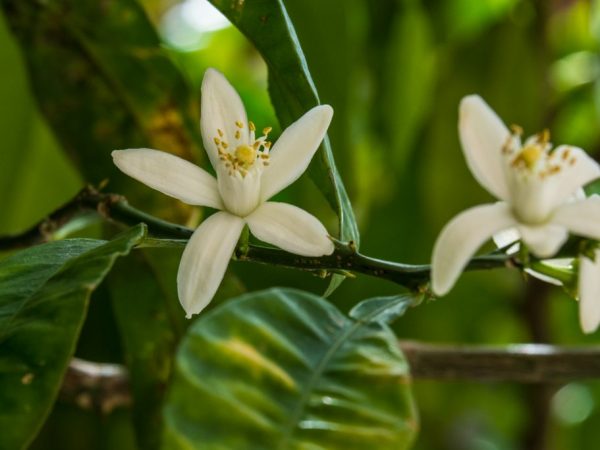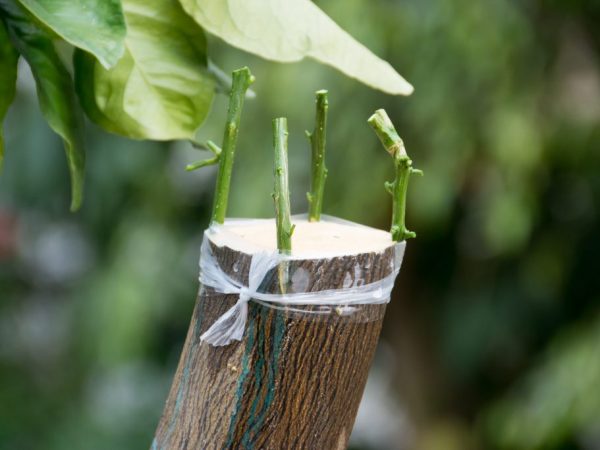Grafting an orange at home
Citrus grown from the seed can develop well, but at the same time remain an ornamental tree: the plant will not begin to bear fruit. If you plant an orange at home, it will delight you with beautiful fruits. To do this, you will need wild and fruitful culture, as well as some knowledge.

Grafting an orange at home
Growing stock
It doesn't matter what kind of citrus plant you choose. Various citruses are suitable as a stock:
- orange;
- lime;
- lemon;
- mandarin;
- pomelo.
The grafted culture takes root well. It is better to raise a few wild animals to select the strongest one.
For this purpose, seeds are removed from ripe or slightly overripe fruit. Do not dry them out. The seeds are planted directly into citrus soil, which is bought at a flower shop. The seeds are buried in the soil to a depth of 2-3 cm. The pot is covered with foil or glass - a small greenhouse is obtained. It is placed on a well-lit windowsill. The protection is periodically removed to ventilate the crops.
The seeds are watered every 3 days. Provide additional lighting in winter. The shelter is removed after germination. The timing depends on the quality of the seeds and the conditions created. In the phase of 3-4 true leaves, the strongest seedlings are transplanted into separate pots. Then they need appropriate conditions and care, which includes:
- watering;
- loosening;
- fertilization with special preparations for citrus fruits.
Graft
It is necessary to plant an orange at home when the shoots become lignified and the thickness of the rootstock trunk reaches 5 mm. Some growers also use a thinner wild, but not less than 3 mm in diameter.
Required inventory
To perform the manipulations you will need:
- garden pruner, which must be disinfected;
- razor blade, medical scalpel and utility knife;
- latex gloves;
- insulating tape.
Gloves are used for strapping, since latex is plastic, stretches well, does not tear. They are cut into strips to make turns later. Thanks to such tapes, they provide good contact between the scion and the wild. No air or moisture gets under the gloves.
Slicing

It's not difficult to vaccinate
At home, grafting an orange begins with pruning a branch from a healthy, fruiting tree. She should be 1-2 years old. With the help of a secateurs, leaves are removed from the cutting. The stalks are left to hold the branch for them during grafting. In the future, their condition determines the effectiveness of the procedure:
- the petiole turned yellow and fell off itself - the kidney took root;
- turned black and withered - the grafted plant died.
On the wild, the peel is cut in the shape of an eye. This method is popular: it is not laborious and not very painful for the tree.
Strapping
A responsible stage. Take the ribbon from the glove. The winding is produced according to the following recommendations:
- the direction should be from bottom to top, and then vice versa;
- the strip is pulled as much as possible, then the fit will be tight;
- the next turn is imposed on the previous one by 1/3 of its width.
The strapping is done by fixing one edge of the strip with a finger just below the inoculation site.
They control all the time so that the adherence of the kidney to the stock is not disturbed. If there is a displacement, correct it. Near the petiole, the winding is continued, bypassing it carefully. At the edge of the cut, they wrap it several times and begin to move in the opposite direction. You get a double winding. The bottom is fixed.
Further actions
The plant is placed in a warm place. To activate the enhanced sap flow, the tree is watered abundantly. Further moisten the soil as needed. After 5 days, the petioles are examined to see if the kidney has taken root. If all is well, after 10 days it falls off. After another 3 weeks, the harness is removed (latex is optional).
If, during budding, new shoots appear at the top of the wild, they are removed. This stimulates the germination of the grafted kidney. When a branch grows out of it and the first leaf is formed, the top is cut off.
After germination, the bud is pinched or pulled with wire to the rootstock branch. In this way, the growth of the cultivated plant is directed upward. If a new shoot is found in the wild, it is removed, otherwise it will take on food.
The transplant is carried out after the sprouted branch is fully formed, but not earlier than several months. The timing of its ripening depends on many factors:
- illumination;
- fertilizers;
- season.
Conclusion
The orange should be grafted in stages, taking into account all the subtleties of the process. It requires patience and attention, but a tree propagated in this way pleases with fruits and inherits the desired characteristics.
An adult plant is also used as a stock. To make the crown symmetrical, the grafting is done on several branches. For scions, sometimes different types of citrus are taken.


